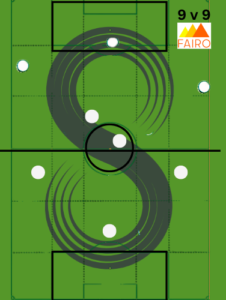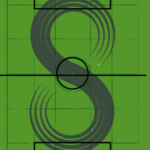Brushstrokes in Soccer Formations | 7 v 7 & 9 v 9
Soccer Formations in 7 v 7 and 9 v 9 |What images do you convey for U9 – U13 players? Principle of “Creativity.”
The English word rondo comes from the Italian form of the French rondeau, which means “a little round”. Today the word rondo is widely used in the English language to refer to any musical work, vocal or instrumental, containing a principal theme which alternates with one or more contrasting themes. Wikipedia
Johan Cruyff had a firm belief in the power of positional play, where triangles play a critical role where one, “Cannot play dominant football with (flat) 4-4-2. Triangles disappear. You should always have triangles, only then you have passing options.” – Johan Cruyff
Dear Reader,
While I’m actively learning about soccer formations, I recognize there’s more to explore. Unfortunately, licensing limitations hinder my access to certain resources. However, I’m dedicated to ongoing education through books, articles, training materials, videos, and by immersing myself in the game. If you’re reading this and have thoughts to share, I’d love to hear them! Whether you want to offer support or criticism on my ideas, engage in a conversation about soccer formations, or simply have a different perspective, please reach out to fairosportsoccer@gmail.com
Sincerely,
Stephen Swanger
I take a slightly different approach when I explain to children and imagine the ideal formation as a series of circles, with key players acting as the “dots” within those circles. Or, rather small games within the game, or musically a “form that contains a principal theme (sometimes called the “refrain”) which alternates with one or more contrasting themes, generally called “episodes”, but also occasionally referred to as “digressions” or “couplets.” For me brushstrokes, circles, and even random scribbles mean “creativity,” which is the primary principle that I teach at this level in attacking.
Because I primarily am working with U9 to U13 players, here’s how this translates to formations in 7v7 and 9v9 soccer:
7v7 – 1-2-3-1 (One Big Circle, One Dot)

- Big Circle: The entire playing field is our big circle. We aim to control possession and keep the opponent outside this circle.
- Two Small Circles: Imagine a figure-eight shape created by their movement.
- The Dot: The #6 midfielder, positioned in front of the central defenders, acts as the “dot” in the center of the figure-eight. This player is crucial for connecting defense and attack, providing a constant option for receiving the ball and initiating attacks.
9v9 – 1-4-1-3 (One Big Circle, Two Dots)

- Big Circle: Similar to 7v7, the entire field is our big circle.
- Two Smaller Circles: The back four defenders with a midfielder, form their own small circle. The three high up the field create another small circle.
- The Dots: The #6 and #8 midfielders act as the “dots” in this formation. The #6 sits in front of the defense, similar to the 7v7 setup, providing a link between defense and midfield. The #8 operates in a more advanced position within the attacking midfield circle, creating opportunities for forward play.
Why Circles and Dots?
This approach emphasizes constant movement and connection between players. The circles represent areas of control, and the dots are the key facilitators within those areas.
Here are some benefits:
- Flexibility and Adaptability: Circles can expand and contract as needed, allowing the team to adapt to different game situations.
- Unpredictability: With players constantly moving within the circles, the opponent struggles to predict passing lanes and movements.
- Strong Passing Options: The “dots” ensure there are always passing options available, keeping the ball moving and creating opportunities.
Attacking Soccer: A Brushstroke Analogy for Soccer Formations
Imagine the attacking phase of soccer as a masterpiece being created on the pitch. Each element contributes to the final product, the goal, just like each brushstroke builds upon the last. Here’s how the soccer formations analogy breaks down:
-
Build-up Play:
- Broad brushstrokes: The team, as a unit, makes wider movements across the field, progressing the ball towards the opponent’s goal. Short, controlled passes and switches of play establish a foundation for the attack.
- Layering the canvas: Varying the pace and direction of these early movements stretches and disorganizes the defense, creating space for later attacking actions.
-
Passing:
- Connecting strokes Each pass acts as a single brushstroke, connecting players and moving the ball towards its target.
- Different strokes for different folks: Varying the type of pass (ground, lofted, chipped) adds depth and keeps the defense guessing.
- Building the picture: A series of successful passes creates a cohesive flow of movement, like building a clear image on the canvas.
-
Individual Skills:
- Artists with the ball: Dribblers become the artists, using their close control to paint pictures with their movement within their designated areas on the field.
- Fancy footwork: Skills like flicks, stepovers, and tight turns add intricate details and surprise elements to the attacking picture.
- Finding space: The dribbler uses their artistry to find space for themselves or teammates within the overall attacking flow.
-
Surprise and Deception:
- Unexpected strokes: Just like an artist can use unexpected strokes to create depth and surprise, attackers can use feints, changes of pace, and layoffs to keep defenders guessing.
- Layoffs & dummy runs: These create space for teammates making runs into dangerous areas, adding a layer of surprise to the attack.
- Disrupting the defense: Unexpected movements disrupt the defensive line, creating opportunities for exploitation.
-
The Goal:
- The masterpiece complete: The final product, the goal, is the culmination of all these creative brushstrokes coming together in a moment of perfect execution.
- Teamwork & vision: A successful goal requires a shared vision and precise execution from all attackers, just like a masterpiece requires a cohesive plan by the artist.
- A moment of beauty: The goal is a celebration of individual skill, tactical awareness, and teamwork, a beautiful moment on the field


